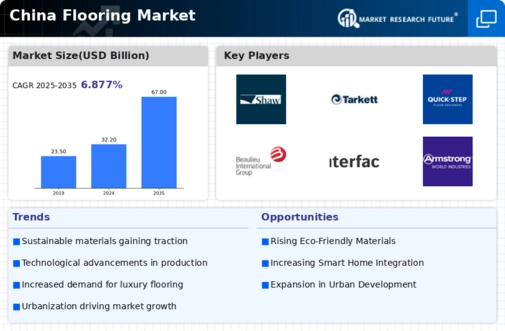Environmental Regulations and Standards
The implementation of stringent environmental regulations in China is influencing the flooring market. As the government emphasizes sustainability, manufacturers are compelled to adopt eco-friendly practices and materials. By 2025, it is anticipated that compliance with these regulations will drive a shift towards sustainable flooring options, such as bamboo and recycled materials. This transition not only aligns with consumer preferences for environmentally responsible products but also positions the flooring market favorably in a competitive landscape. The focus on sustainability is likely to reshape product offerings and create new opportunities for growth within the flooring market.
Evolving Consumer Preferences and Trends
Consumer preferences in China are evolving, significantly impacting the flooring market. There is a noticeable shift towards modern and stylish flooring solutions that reflect individual tastes. In 2025, trends indicate a growing demand for luxury vinyl tiles and engineered wood, which offer both aesthetic appeal and durability. This evolution in consumer behavior suggests that the flooring market must adapt to meet these changing demands. As consumers increasingly prioritize design and functionality, manufacturers are likely to innovate and diversify their product lines. The ability to respond to these trends will be crucial for success in the competitive flooring market.
Technological Advancements in Manufacturing
Technological innovations in manufacturing processes are transforming the flooring market in China. Advanced production techniques, such as automation and digitalization, enhance efficiency and reduce costs. In 2025, it is estimated that the adoption of smart manufacturing technologies could increase production capacity by up to 30%. This shift not only improves the quality of flooring products but also allows for greater customization options. As manufacturers embrace these technologies, the flooring market is likely to see a diversification of product offerings, catering to the evolving preferences of consumers. The integration of technology in manufacturing processes is thus a crucial driver for the flooring market.
Urbanization and Infrastructure Development
The rapid urbanization in China is a pivotal driver for the flooring market. As cities expand, the demand for residential and commercial spaces increases, leading to a surge in construction activities. In 2025, urbanization rates in China are projected to reach approximately 65%, which translates to a significant rise in flooring requirements. The flooring market is expected to benefit from this trend, as new buildings necessitate various flooring solutions. Additionally, government initiatives aimed at improving infrastructure further stimulate demand. The construction sector's growth, coupled with urbanization, indicates a robust future for the flooring market, as it adapts to the evolving needs of urban environments.
Rising Disposable Income and Consumer Spending
The increase in disposable income among Chinese consumers is a significant driver for the flooring market. As economic growth continues, more households are willing to invest in home improvement and renovation projects. In 2025, consumer spending on home furnishings, including flooring, is projected to rise by approximately 15%. This trend indicates a growing preference for high-quality and aesthetically pleasing flooring options. The flooring market is likely to benefit from this shift, as consumers seek products that enhance their living spaces. The correlation between rising income levels and increased spending on flooring solutions underscores the potential for growth in this sector.























Leave a Comment